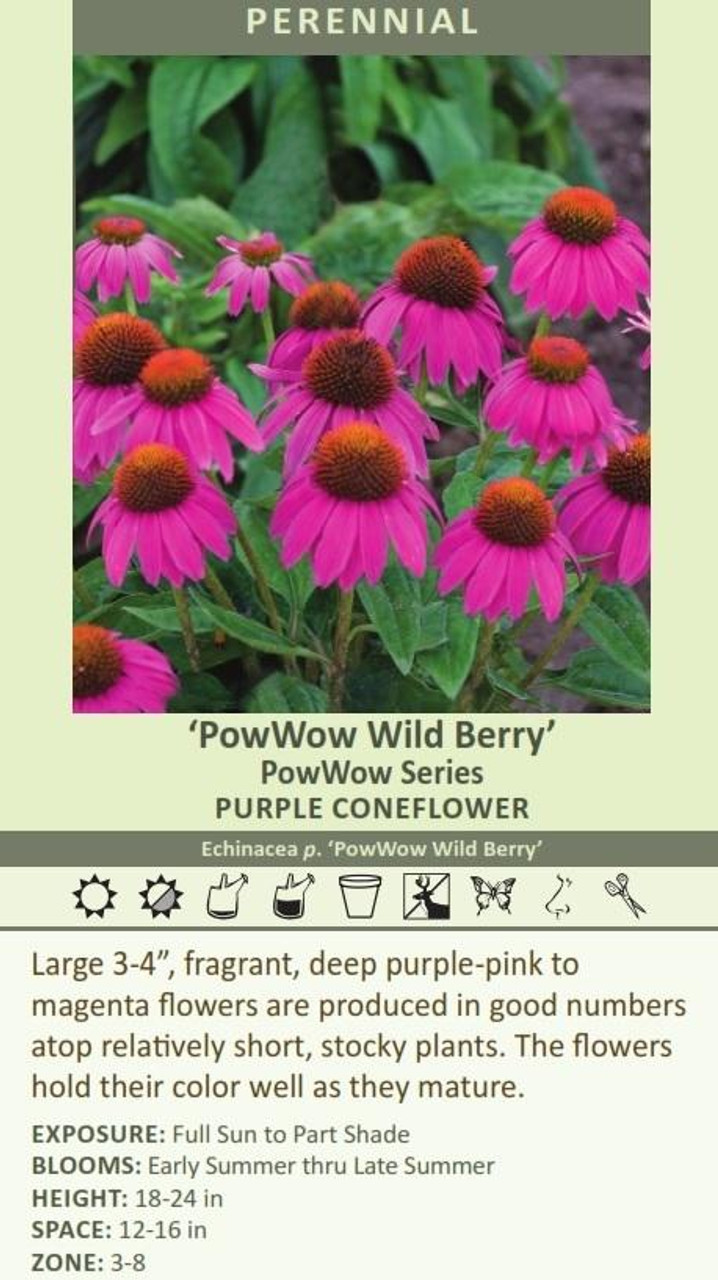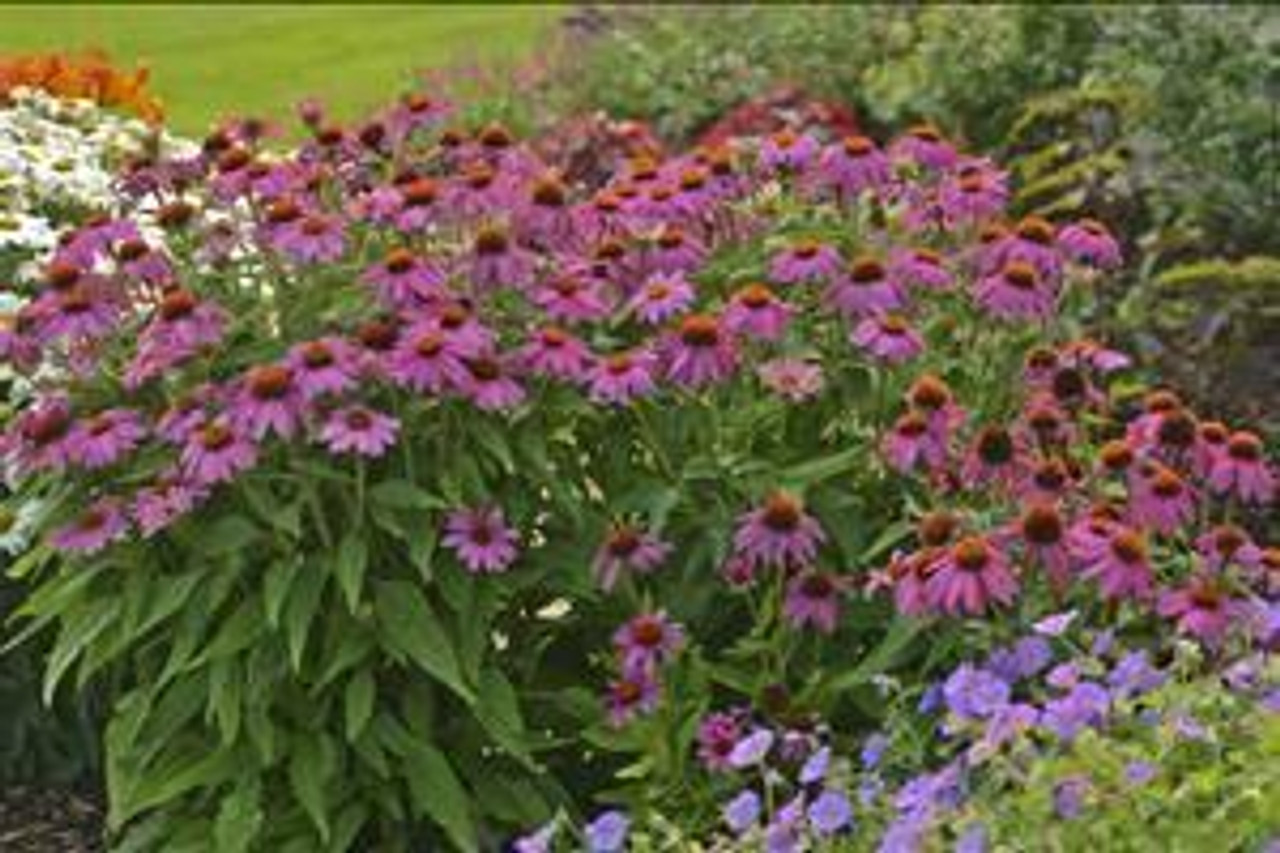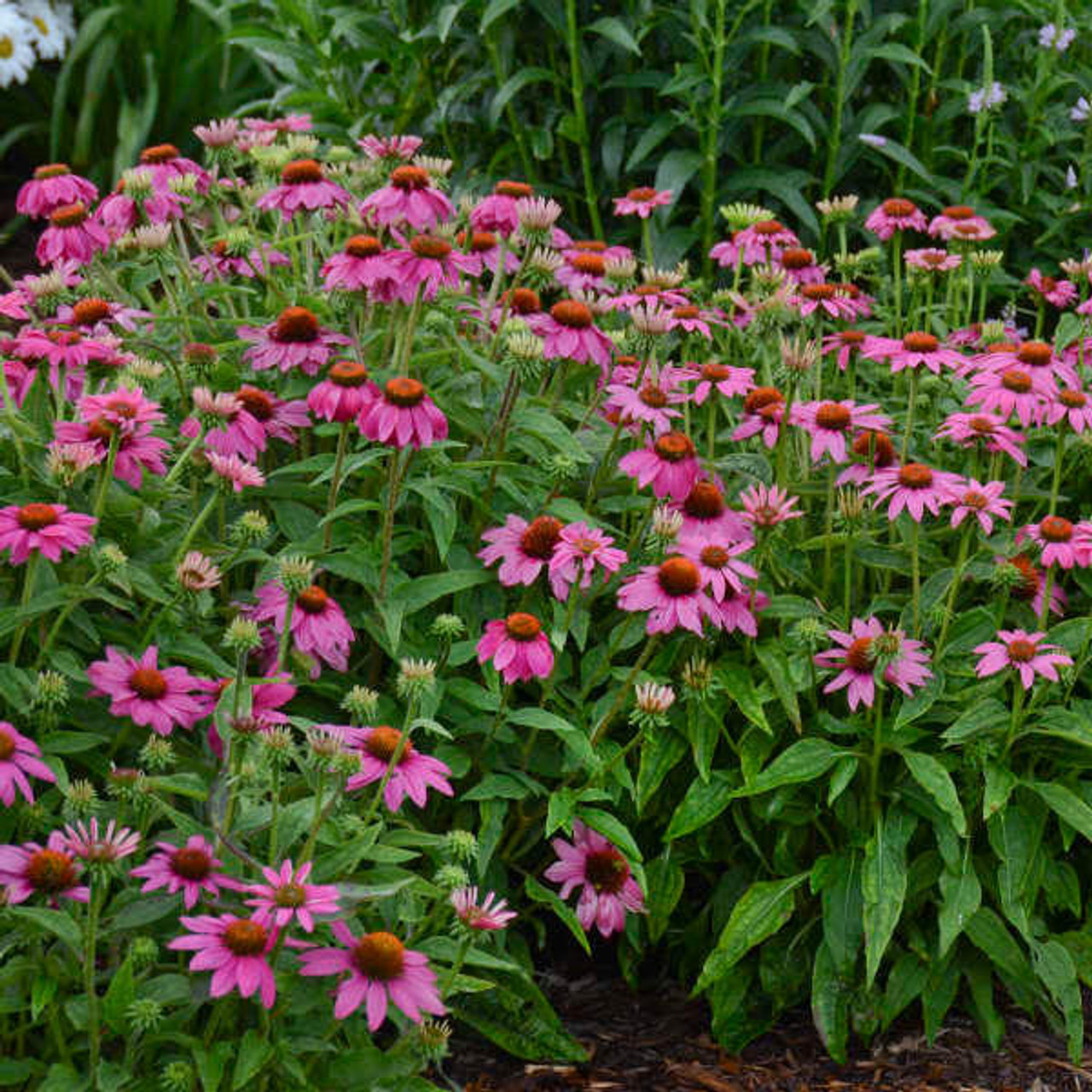Product Description
Echinacea purpurea 'Pow Wow Wild Berry' (30)ct Flat
Common Name: Coneflower;
This variety is incredibly impressive for a seed grown Echinacea. It’s no surprise that it is a 2010 All America Selections winner.
In our trials, we noted how floriferous the plants were. Each stocky, relatively short plant carried a bouquet of fragrant, 3-4”, deep purple-pink to near-magenta flowers on stiff, branched stems. More branches result in more flowers per plant and a showier display in the landscape. We noted that the older flowers were nearly the same magenta color as the new flowers; the flowers held their bright coloration very well as they aged. This first year flowering perennial reportedly keeps on blooming without having to be deadheaded, though you may still want to trim back spent flowers to maintain a tidy appearance.
Praised for their cheerful brightly colored flowers, coneflowers are a mainstay in today's garden. Be sure to leave some spent blooms on the plants in the fall because their seeds provide winter food for finches and other birds. The dried seed heads also provide architectural interest in the winter.
Height: 18.0-24.0 Inches
Spread: 12.0-16.0 Inches
Hardiness Zones: 3,4,5,6,7,8
Flower Color: Pink Shades
Foliage Color: Green shades
Full Sun (> 6 hrs. Direct Sun) - Part Shade (4-6 hrs. Direct Sun)
Low to Average Water Needs
Poor to Fertile Soil Quality
Bloomtime: Early Summer - Late Summer
Attracts Butterflies and Songbirds
Bee Friendly
Deer Resistant
Seasonal Interest: Dried Seed Heads
Growth Rate: Medium
Border Plant, Container, Cut Flower, Dried Flower, Drought Tolerant, Fragrant Flowers, Mass Planting
Imagine a vibrant burst of berry-colored blooms that dance in your garden all summer long, attracting a flurry of butterflies and bees. This is the magic of Echinacea p. 'PowWow Wild Berry', a coneflower that is as captivating as it is easy to grow.
Echinacea p. 'PowWow Wild Berry' is a showstopper in the world of coneflowers. This improved variety of Echinacea purpurea boasts striking deep rose-purple flowers that hold their vibrant color exceptionally well. Not only is it a beauty, but it is also a workhorse, blooming profusely from early summer until frost with minimal need for deadheading.
This compact and well-branched coneflower typically reaches a height of 16-24 inches and a width of 12-16 inches. Its fragrant flowers and sturdy stems make it a delightful addition to any garden, and it is particularly well-suited for smaller spaces or containers.
But there is more to this coneflower than meets the eye. As a seed strain of the North American native Echinacea purpurea, it carries the legacy of hardiness and adaptability, thriving in a variety of conditions. It is also a favorite among pollinators, attracting bees, butterflies, and hummingbirds with its vibrant blooms. And for those eager to see results, this remarkable cultivar blooms in its first year from seed, adding a splash of color to your garden almost instantly.
Echinacea p. 'PowWow Wild Berry' is genetically short, so it maintains its compact form without the need for plant growth regulators (PGRs). It is also faster to flower and more floriferous than other seed-grown varieties, making it a top choice for gardeners seeking quick and abundant blooms.
Originally found in open woodland edges, clearings, savannas, and prairies of the eastern United States, this coneflower has a moderate growth rate and is a valuable addition to any garden.
Growing Conditions Echinacea p. 'PowWow Wild Berry' thrives in warmth and sunshine. For optimal growth and flowering, provide it with at least 6 hours of direct sunlight daily. While it can tolerate some shade, prolonged periods with less than 4 hours of direct sunlight may result in fewer blooms and a weaker plant.
This coneflower prefers well-drained soil that is rich in organic matter. It is remarkably adaptable and can tolerate a wide range of soil types, including average, sandy, clay, shallow-rocky, and even dry soil. It is also tolerant of humidity and salt. However, consistently soggy conditions should be avoided to prevent root rot.
This coneflower is unpalatable to deer and other herbivores, making it a great choice for gardens where these animals are a concern. It is also tolerant of black walnut, so you can confidently plant it near black walnut trees without worry.
The ideal temperature for Echinacea p. 'PowWow Wild Berry' is between 0 and 35°C (32 and 95°F).
Care and Maintenance Echinacea p. 'PowWow Wild Berry' is a low-maintenance plant that thrives with minimal intervention. Here is how to ensure its continued health and vigor:
- Watering: Water regularly during the first growing season to help the plant establish a strong root system. Once established, it becomes quite drought-tolerant. However, during extended periods of dry weather, supplemental watering will help maintain its lush foliage and vibrant blooms. Applying mulch, such as fiber mulch or wood chips, can help retain moisture and suppress weed growth.
- Fertilizing: Coneflowers are not heavy feeders and can suffer from over-fertilization. If your soil is poor, amend it with compost in the spring to provide essential nutrients. To prevent magnesium and iron deficiencies, consider supplementing with 0.05% magnesium sulfate and chelated iron 1-2 times as needed.
- Deadheading: While Echinacea p. 'PowWow Wild Berry' can rebloom without deadheading, removing spent blooms encourages continuous flowering and maintains a tidy appearance.
- Pruning: In late winter or early spring, before new growth emerges, cut back the dead stems to about 3-5 inches above the ground. This promotes bushier growth and prevents the plant from becoming leggy.
- Winter Care: This coneflower is cold-hardy and generally does not require winter protection. However, leaving the seed heads in place over winter provides food for birds and adds visual interest to the garden. In colder regions, you can apply a light layer of mulch around the base of the plant after the ground freezes to help insulate the roots.
- Dividing: To maintain plant vigor and prevent overcrowding, divide clumps every 4 years or so. The best time to divide Echinacea p. 'PowWow Wild Berry' is in the spring or fall.
It is worth noting that Echinacea p. 'PowWow Wild Berry' may go dormant in hot summers, with its foliage turning yellow. This is a natural process and not a cause for concern.
Problems While generally disease-free, Echinacea p. 'PowWow Wild Berry' can occasionally be affected by Japanese beetles and leaf spot. If you encounter these issues, consider using organic pest control methods or consulting with your local garden center for appropriate treatments.
Landscape Uses Echinacea p. 'PowWow Wild Berry' is a versatile plant that can be incorporated into various landscape designs. Its compact habit and vibrant color make it a perfect choice for:
- Borders: Edge your garden beds or walkways with these eye-catching coneflowers to create a stunning display.
- Meadows: Incorporate them into wildflower meadows or prairie-style plantings to add a touch of vibrant color and attract pollinators.
- Naturalized Areas: Allow them to naturalize in informal gardens or woodland settings, where they will readily self-seed and spread, creating a beautiful and low-maintenance display.
- Wildflower Gardens: Combine them with other native wildflowers to create a haven for pollinators and beneficial insects.
- Cottage Gardens: Their cheerful blooms and informal growth habit make them a perfect fit for cottage gardens, where they can be mixed with other flowering perennials.
- Pollinator Gardens: Attract bees, butterflies, and hummingbirds to your garden with these nectar-rich blooms.
- Specimen Plant: Display their beauty by planting them as a focal point in the garden or in containers.
- Mass Plantings: Create a dramatic effect by planting them in large groups or drifts.
- Groundcover: Their ability to tolerate foot traffic and spread moderately makes them a suitable groundcover for sunny areas.
- Xeriscaping: Their drought tolerance makes them a valuable addition to water-wise gardens.
Companion Plants: Consider pairing Echinacea p. 'PowWow Wild Berry' with other sun-loving perennials such as:
- Butterfly weed (Asclepias tuberosa)
- Black-eyed Susans (Rudbeckia fulgida 'Goldsturm')
- Wild bergamot (Monarda fistulosa)
- Dense blazing star (Liatris spicata)
- Little bluestem (Schizachyrium scoparium)
- Sideoats grama (Bouteloua curtipendula)
Propagation Echinacea p. 'PowWow Wild Berry' can be propagated through various methods:
- Seeds: Sow seeds in spring or autumn. For faster germination, soak the seeds in warm water for 20-30 minutes before sowing.
- Division: Divide clumps in spring or fall to create new plants.
- Root Cuttings: Take root cuttings from late fall to early winter.
Echinacea p. 'PowWow Wild Berry' is a true gem for any garden. Its compact habit, vibrant and long-lasting blooms, and low-maintenance nature make it a favorite among gardeners of all levels. This coneflower thrives in sunny locations with well-drained soil and is remarkably adaptable to various conditions. Whether you are creating a vibrant border, a pollinator paradise, or a water-wise landscape, Echinacea p. 'PowWow Wild Berry' is sure to bring beauty and life to your garden for many years to come.
Thirty (30) plants per flat (or tray). Approximate Plug Measurements: 3 inches deep x 2 inches wide.
Other Details
The most important part of the plant is its root system. Healthy roots are the foundation of a healthy, vibrant plant. The type of plug container used is based on the specific needs of the plants. Perennials offered as bare root traditionally perform better when planted as bare root.Planted in a specialized mix, potted plants have well established root systems. Top growth stage will vary depending on the current life cycle and time of year when shipped. In Winter and early Spring dormant plants may be shipped. Dormant plants may be planted right away, even before the last frost date.
Most bare root varieties are field grown for at least one season, though Hemerocallis and Hosta are grown for two seasons. The bulk of the soil is removed during the harvesting process and the tops of most varieties are trimmed back to the crown. They are graded, packed in shredded aspen or sphagnum moss and stored in freezers until ready to be shipped.
See our Container Sizes and Bare Root Perennials pages for more information.
Plant information and care is provided in the Overview section, Plant Genus Page and general information is provided in the Planting Care & Guides. Additional questions can be asked on each Plant page.
Plant Spacing: Using the maximum mature spread or width of a plant to guide spacing, ensures space to grow to full size. To fill an area sooner, plant them closer together. Just remember, future thinning or transplanting may be needed.
Water: Keep a close eye on newly planted perennials, especially throughout the first growing year. Most early plant loss is due to too much or too little water!























